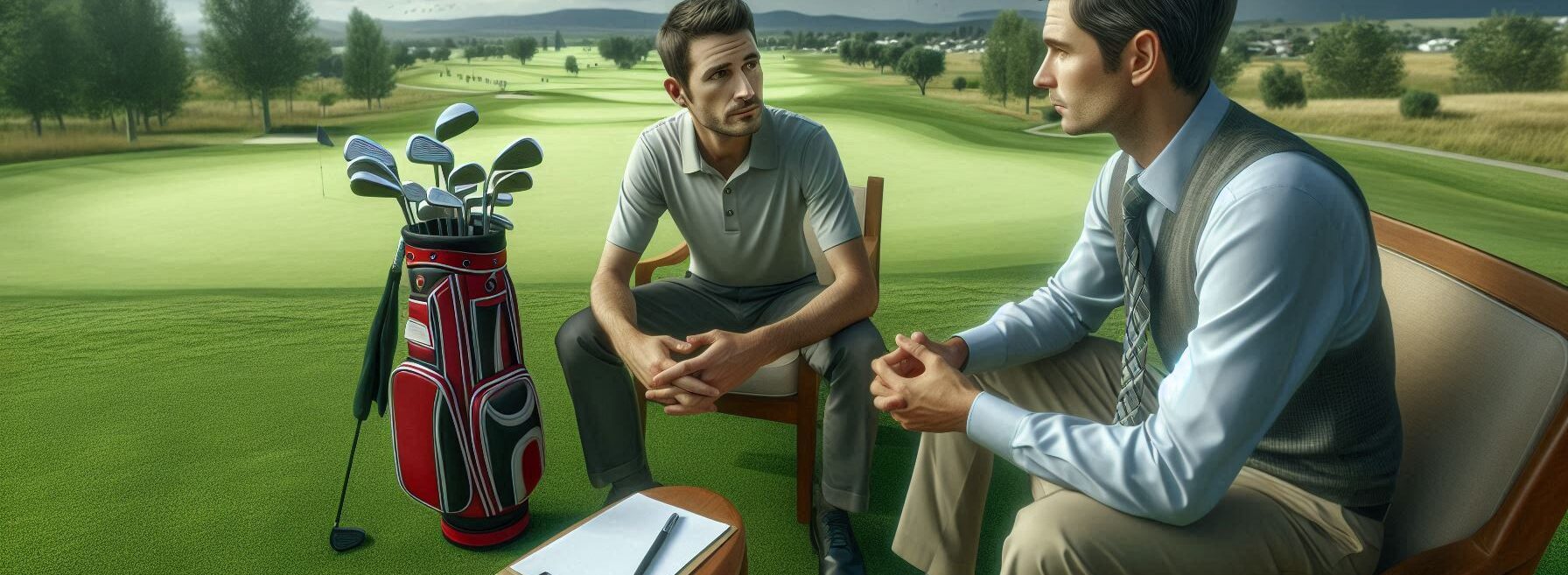Top Takeaways and Key Concepts
Please Note: This post may contain affiliate links. If you click one of them, we may receive a commission at no extra cost to you. As an Amazon Associate, I earn from qualifying purchases.
→ Perfect your swing mechanics by focusing on grip, stance, and balance for reliable, consistent shots.
→ Practice your short game daily to sharpen chipping, putting, and scoring control around the greens.
→ Think strategically on the course to minimize risks and play smarter, more efficient rounds.
→ Strengthen your mental focus through visualization, calm breathing, and steady concentration under pressure.
→ Get custom-fitted equipment to match your swing style, height, and comfort for maximum performance.
Summary of This Article
Improving your golf game is all about balance—between technique, mindset, and strategy. This article shows how refining your swing, short game, and focus leads to steady improvement. With properly fitted clubs and smarter shot choices, you’ll play with more confidence, consistency, and joy—transforming each round into a chance to master the game.
Video Summary
Are you sick of seeing your buddies get better at golf while you stay stuck in the sand trap of mediocrity? Believe me, I've been there! You might feel like everyone else knows something you don't. But don't worry; I'm here to assist you figure out how to lower those annoying scores. Let's look at some useful ideas and tricks that could make your game go from “meh” to great!
Mastering Your Swing Mechanics

“Golf is about how well you can control your emotions… especially when you miss an easy putt.” — Ernie Els
Let's start by talking about how you swing. Think about trying to make a cake without following the directions. Instead, you can get something that looks like a pancake. Your golf stroke is the same. If it's even a little bit off, it might cause big problems on the course.
What can we do to solve this? Okay, let's go through it one step at a time. First, pay attention to your grip; it's the most important part of your swing. A good grip is like having decent shoes on when you run a marathon. You could trip and fall before you get to the finish line if your shoes are too loose or too tight. Your golf game is the same way; if you don't hold the club correctly, your ball might go off course faster than you can say “fore!”
Now, make sure your hands are in the right place when you hold the club. Your fingers should wrap around the handle in a way that feels good and sturdy, like you're giving it a reassuring handshake. You don't want to strangle the club like it just insulted your favorite player. Instead, you want to hold it in a way that is both calm and secure. The overlapping grip is a frequent way to hold anything. It means that one pinky overlaps the index finger of the other hand. The interlocking grip is for people who like to feel more connected. Try both out until you find the one that feels best for you.
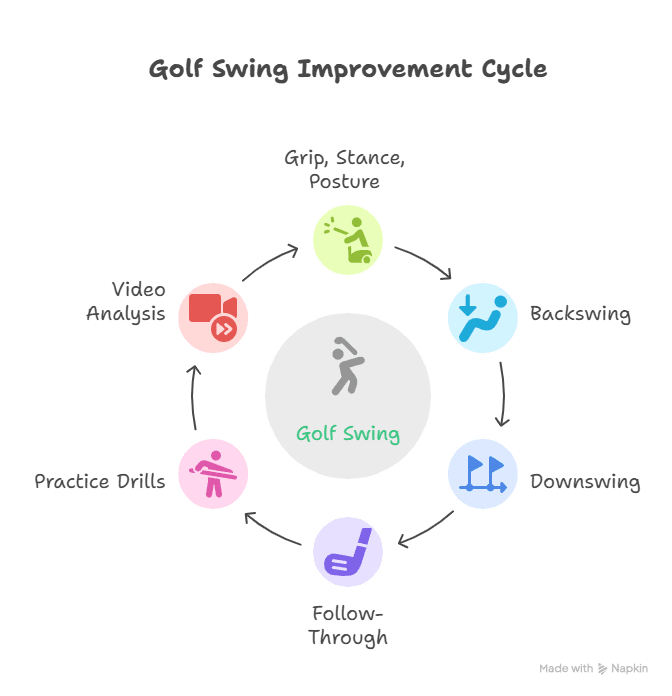
The next step is to take a balanced position. Imagine yourself as a superhero, with your feet shoulder-width apart, knees slightly bent, and ready to fly at any moment! This arrangement keeps things steady and makes the swing go more smoothly. It's like attempting to balance on a seesaw whether you're standing too wide or too narrow. Good luck keeping everything steady!
Make sure your feet are parallel to where you want to hit the ball as you set them up. This alignment will help your shot go straight down the path you want it to (or at least closer than if you were shooting at that tree over there). And don't forget about how weight is spread out! You should try to keep most of your weight over the balls of your feet, not leaning back like you're waiting for someone to bring you refreshments.
Once you know how to stand, practice moving your weight during the swing itself. As you start back with your club and progress into that wonderful follow-through posture (the one that makes everyone look at you in admiration), let gravity do its job as you stay balanced.
Did you know that one golfer tried to master his swing mechanics by practicing in his living room with a full-size mirror and a rubber chicken? He claimed it was the perfect way to focus on his form—every time he made a bad swing, the chicken would squawk, reminding him to lighten up! His friends started calling him “The Chicken Swinger,” and while he never quite broke par, he definitely broke into laughter every time he practiced. So remember, when working on your swing, don’t be afraid to embrace the absurd—it might just be the secret ingredient to mastering your game (and entertaining your neighbors)!
It takes time and patience to learn these basics, but believe me, once you do, you'll notice a tremendous difference in how well and consistently you play on the course!
But it's very vital to do a lot of practice! At the driving range, work on different areas of your swing, like your follow-through and pace. You should remember that it took a long time to build Rome. It will also take a long time to get your swing precisely correct. Over time, these small changes will add up, making your hits more consistent and lowering your scores.
Short Game Secrets: Chipping and Putting

“The only thing worse than having no chance at winning is having no chance at losing!” — Bernhard Langer
Now let’s get down to business—the short game! Many golfers underestimate how crucial chipping and putting are when it comes to lowering scores. Honestly, have you ever heard someone say they love hitting their driver more than sinking putts? Didn’t think so!
To improve your chipping skills, practice makes perfect (and yes, that cliché holds true!). Set up targets at varying distances around the green and try landing chips close to those spots. This exercise helps build confidence in your touch around the greens—because let’s face it; nobody wants their ball rolling past the hole like it's auditioning for an Olympic sport!
When it comes to putting, reading greens is an art form all its own! Ever notice how some golfers stare at their lines like they’re deciphering ancient hieroglyphics? When you understand slopes and breaks, it can make all the difference during crucial putts. Take time before each shot to assess how much downhill or uphill you're dealing with—it’ll pay off big time.
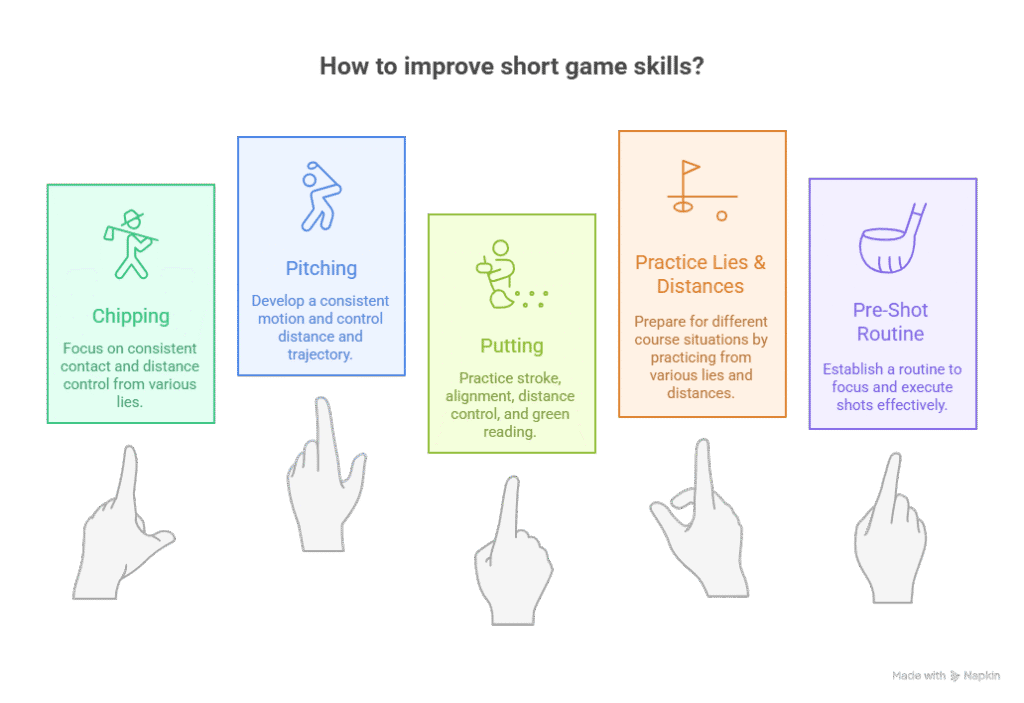
Many players do well by adopting visualization tactics right before they putt, which is interesting. It may sound like magic or a Jedi mind trick, but believe me, it really does work! Picture yourself standing over that small white ball, feeling the weight of your club in your hands, and then picture the ball gliding easily into the cup as if it were meant to be excellent. I all, who wouldn't want to be the star of their own golf highlight reel?
Before you hit the ball, take a moment to close your eyes. (Okay, maybe not when you're on the green—safety first!) Imagine every little thing: how the grass feels under your feet, how the sun shines on the hole, and even how your buddies are leaning forward in excitement. Imagining this scenario can help you feel calm and sure of yourself, which can change your putting game from “I hope this goes in” to “Oh yeah, it's going in!”
Now, let's be honest: putting can be like trying to thread a needle during an earthquake. There is real pressure! Everyone is watching you closely on the green, ready to swoop down at the first indication of failure. But if you make visualization a part of your daily life, it might help you turn those nerves into something good. Instead of thinking about all the scary things that could happen (such missing the ball and sending it rolling toward someone's picnic), think about completing the perfect stroke.
Now things start to become interesting! Who knows? You might one day tell stories about how you sunk that amazing 30-footer while everyone else watched in wonder. You might tell them how you imagined every inch of that putt, including the slope and the break, and then hit it perfectly like a pro! When your friends hear every word, their faces will light up. They'll suddenly see you as an artist painting masterpieces on greens all over the place, not simply as another golfer.
Did you know that there’s a legendary golfer who swears by using a rubber chicken as his chipping and putting coach? He claims that every time he misses a shot, the chicken's squawk reminds him to “wing it” instead of overthinking! His friends say it’s not just about improving his short game; it's also about keeping his sense of humor intact. Now, whenever he sinks a long putt, he dramatically raises the chicken in triumph, declaring, “It’s all in the wrist and the poultry!” So next time you're practicing your chips or putts, remember: if you can’t find joy in your game, maybe it's time to channel your inner poultry pro!
Use this visualization method often, even when you're not in class, to get the most out of it. Take some time before bed or during breaks at work (don't tell your boss!) to visualize yourself making putts from different distances and angles. Over time, you'll build up a mental library of successful shots that you may utilize whenever you need them.
In the end, using visualization techniques before you putt could affect how you play each hole. And who doesn't want to wow their friends with wonderful stories about putting? Remember to see the shot in your thoughts before you take it the next time you think you can't make it.
Course Management: Play Smart

“The hardest part of golf? Convincing your friends that ‘just one more’ means ‘just one more round.’” — Kathy Whitworth
When we talk about playing wisely, we can easily go on to course management, which is an important part that weekend warriors who just want to bomb drives down fairways frequently forget. Have you ever aimed straight at flags and gotten into trouble? Yeah, we've all been there!
To lower your scores efficiently, you need to know when to take chances and when to play it safe. It's like selecting whether to jump into the deep end of the pool or stay in the shallow end. Sometimes it's best to play it safe. Picture yourself on the course, with 150 yards to go and only needing a par to stay in the game. Why would you ever take out your driver? That's like attempting to hang a picture with a sledgehammer—it's not needed and will probably make things worse!
Instead of going all out every time (which generally ends in disaster), think about which clubs will work best according on the distance and the weather. Honestly, not every shot needs you to be like Tiger Woods. Sometimes being smooth is much better than being strong! If you're up against a tough lie or some annoying wind, grabbing your 7-iron instead of your driver might keep you from having to go into the woods or, even worse, that dreaded water hazard.
I remember one round when I felt I could take over the world by hitting my driver off the tee every time. Spoiler alert: that didn't go well! After losing a few balls and making some really bad choices, I discovered that sometimes all I needed was a good old-fashioned 5-wood. When you make smarter choices instead of just swinging for the fences, your score can seem a lot better.
It's also interesting to notice that being safe doesn't mean giving up enjoyment or excitement. It's like playing chess: sometimes it's better to wait and watch than to jump in without thinking. If you know there's difficulty nearby, like the trees on the right or the bunker up ahead, it could be preferable to lie up than go for broke. This way, you don't have to put everything on one swing, which makes your following shot easier.
And don't forget about how the course looks right now! Trying to break your driver when it's rainy or windy could make things worse instead of better. If this happens, you might want to choose clubs that help you control distance and direction better. In these cases, a decent hybrid can frequently perform wonders. It gives you both power and precision without making you feel like you're auditioning for “The Biggest Loser” golf edition.
Did you know that there’s a golf course in Scotland where the designer intentionally placed a giant inflatable dinosaur on the 7th hole? The idea was to encourage players to “play smart” by avoiding the dino's shadow—because who wants to be known as the golfer who got eaten by a T-Rex? Locals say it’s not just about avoiding hazards; it’s also a great way to practice your mental game. Every time someone hits into the rough, they joke that it's “dino-sore” decisions! So remember, when you're strategizing your next shot, just think: would I rather face an alligator or an inflatable dinosaur? Choose wisely!
Ultimately, mastering this balance between risk-taking and conservative play is crucial in lowering those pesky scores we all want to improve upon. So next time you're out there battling Mother Nature and her obstacles, take a moment to assess your options carefully before swinging away wildly like you're at a carnival game! You’ll find that thoughtful decision-making can make all the difference—and who knows? Maybe you'll walk away with that shiny new personal best score!
Also interestingly enough, sometimes finesse beats brute strength any day! Learning when not to go for broke will keep those scorecards looking pretty instead of filled with double bogeys galore.
Mental Game: Stay Focused Under Pressure
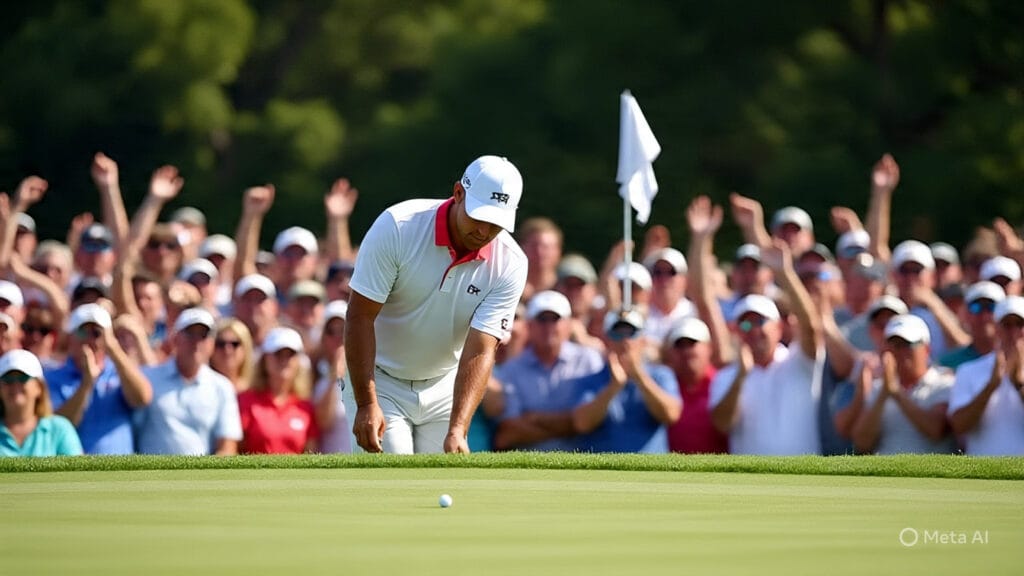
“My favorite club? The one that gets me out of trouble—like the nine-iron or my driver after three drinks!” — Michelle Wie
We shouldn't forget about our mental game because it has a huge impact on how well we play golf! Have you ever observed how some players stay calm under pressure while others fall apart like old bread? The difference is often in how you think.
One thing that has helped me is doing breathing exercises right before I hit the ball (I know this sounds very Zen!). Taking deep breaths can really help calm your anxieties, especially when the stakes are high and every stroke counts toward lowering your overall scores.
And since we're on the subject of focus, let's talk about how important it is to break rounds into smaller parts. Imagine this: you're on the first tee, and it feels like you're looking at an endless marathon of 18 holes. It can be rather scary! But what if I told you that treating each hole like a mini-challenge may make a big difference? Don't think of your round as one lengthy trudge over the course; instead, divide it up into smaller parts. This manner, you may focus on each shot without worrying about what's ahead or behind.

Imagine walking into a bakery full with delicious treats. You might feel sick and overwhelmed if you tried to consume everything at once. But if you take the time to appreciate each pastry one at a time, it will be a great time! Golf is the same. It helps us stay calm and keep our nerves in check when we split our game down into segments and just think about one hole at a time.
Say you're going to the back nine after a terrible front nine. Don't let mistakes from the past haunt you. Instead, see each hole as a fresh start. “Forget about that double bogey; this is a new chance!” I tell myself a lot. I don't have to think about how many strokes I need to make up for later or how many shots I've already taken this way. A fresh journey starts with every swing!
It's fascinating that some golfers even use this strategy when they practice. They'll set goals for certain shoots instead than trying to do everything right at once. For example, if you simply practice your drive on the range and not your putting, you will start to feel more sure of yourself. You don't just run 26 miles right away; you start with shorter distances and work your way up, just like you would if you were preparing for a race.
Now, let's not forget about the times when things get in the way, as when a squirrel steals someone's sandwich or when other players are talking loudly nearby (really, why do they always sound so loud?). When things are crazy, breaking them down might help you stay focused! When you solely think about the task at hand, it's easier to ignore distractions.
So the next time you're out in the sun (or rain) fighting through 18 holes, keep this useful tip in mind: divide your round into smaller parts! Instead of thinking about the entire scorecard, just focus on hitting good strokes one hole at a time. You might find that you love the game more while dropping your scores in ways you never thought possible! Also, who doesn't want a reason to celebrate every small win along the way?
Equipment Matters: Find What Works for You
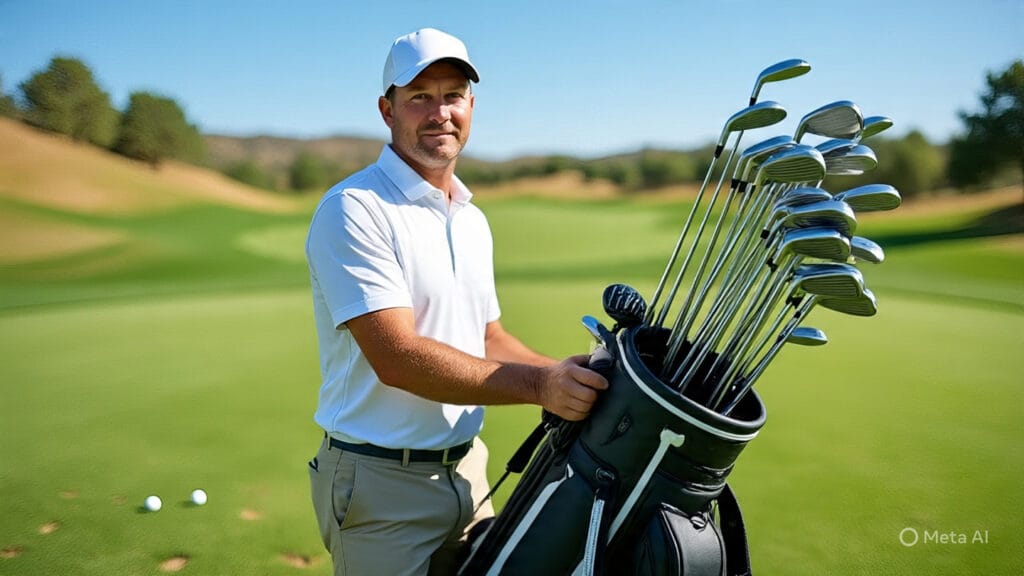
“It took me years to figure out that I was not as good as I thought—I still haven’t figured it out!” — Billy Casper
Your gear is also very crucial! Using clubs that are built particularly for you can really help you play golf better.
Have you ever swung someone else's driver and felt strange or uncomfortable? Yes, that's correct! It feels like wearing shoes that are two sizes too big. Your foot just moves around, and you feel like you're going to fall. The same goes with golf clubs. If you use a club that doesn't fit you, you might ruin your whole game faster than you can say “fore!” That's why it's so vital to have the perfect fit.
Imagine having a driver that feels like an extra arm while you're on the course. When everything about your golf club is just right, from the length of the shaft to the size of the grip, it's like having the best partner in crime on the course. You could think that a fitting session is just something else to do, but trust me, it's worth every second. When you swing a club that was built just for you, you'll be shocked at how much more confident you feel.
During a fitting, professionals will look at your swing and the shape of your body. They will check how tall you are, how far your wrist is from the ground, how fast you swing, and even how you naturally hold the club. This custom process makes sure that every feature of the club works well with your style of play. For instance, if your arms are longer or you tend to stand taller when you hit the ball, they can propose a longer shaft or a different lie angle to help you hit the ball better.
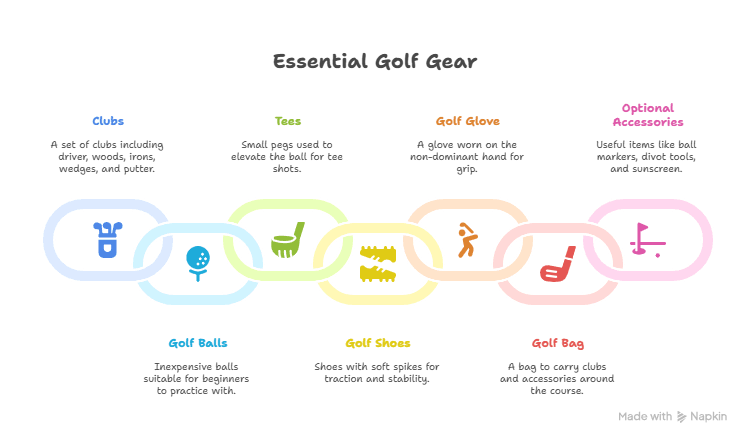
And let’s talk about grips for a second! It may seem minor compared to other aspects of fitting, but the right grip can make all the difference in comfort and control. A grip that's too thick could lead to tension in your hands and forearms (trust me; nobody wants that!). On the flip side, if it's too thin, you'll find yourself overgripping without even realizing it—a recipe for disaster! Getting fitted means finding that sweet spot where everything feels just right.
Now consider this: once you've been properly fitted and start using clubs tailored specifically for you, it's almost like unlocking a hidden level in your golf game! Suddenly those shots that used to veer off into oblivion begin flying straighter down the fairway instead. You'll likely notice improvements not only in distance but also accuracy—talk about hitting two birds with one stone!
Interestingly enough, many golfers underestimate how much their equipment impacts performance until they experience being fitted themselves. I remember my own fitting session vividly; I walked out thinking I knew what I needed only to discover completely new options that transformed my game overnight! It was eye-opening—and maybe even life-changing—in terms of how enjoyable my rounds became afterward.
So next time you're contemplating whether or not to get fitted for clubs—or if borrowing someone else's driver seems tempting—take a moment and think again! Investing time into getting properly fitted means investing in yourself as a golfer. After all, why settle for anything less than perfection when there’s an opportunity waiting just around the corner? Embrace customization because every stroke counts when lowering those scores—and who doesn’t want bragging rights after sinking that incredible putt?
Featured Snippet: The fastest way to lower your golf scores is to master your swing mechanics, strengthen your short game, and play smarter on the course. Focus on proper grip, consistent chipping and putting, and mental focus. Combine strategy with patience, and your confidence and consistency will soar.
Frequently Asked Questions
How can I improve my golf swing consistency?
Focus on your grip, stance, and balance during every practice session. Consistency comes from repetition, rhythm, and staying relaxed throughout the swing.
Why is the short game important in golf?
Your short game—chipping and putting—makes up most of your shots. Improving it directly lowers your scores and builds confidence on the green.
What does course management mean in golf?
Course management means making smart shot choices, avoiding risky plays, and adapting to conditions. It’s about strategy, not just power.
How can I stay calm under pressure while golfing?
Practice deep breathing and visualization before each shot. Focusing on one hole or one swing at a time helps reduce nerves and improve focus.
Does custom golf equipment really make a difference?
Yes, fitted clubs improve comfort, control, and accuracy. Properly sized grips and shafts ensure your swing works with your natural mechanics.
How often should I practice putting and chipping?
Practice daily if possible. Even short sessions focusing on distance control and precision around the greens will quickly improve your short game.
What’s the best mindset for long-term golf improvement?
Adopt a patient, positive attitude. Focus on steady progress, not perfection—every swing and round is an opportunity to learn and grow.
Suggested Resources:
Lower Your Golf Scores: The Complete Guide
https://www.golfdigest.com/story/lower-your-golf-scores-complete-guide
The Importance of Short Game Practice
https://www.pga.com/short-game-practice-tips
Improving Your Mental Game in Golf
https://www.golfmentalgame.com/improve-your-mental-game
How Club Fitting Can Change Your Game
https://www.golf.com/club-fitting-change-your-game
Mastering Course Management Strategies
https://www.golfweek.usatoday.com/course-management-strategies

Kevin Collier is an avid golfer and contributing author at AIGolfTips.com, where he shares his passion for the game through expert tips, techniques, and gear reviews. With years of experience on the course, Kevin offers valuable insights for golfers of all skill levels, helping them improve their game and maximize their potential. Whether discussing swing mechanics or the latest in golf technology, Kevin's engaging approach aims to inspire and educate fellow golf enthusiasts to elevate their performance and enjoy every moment on the green.


